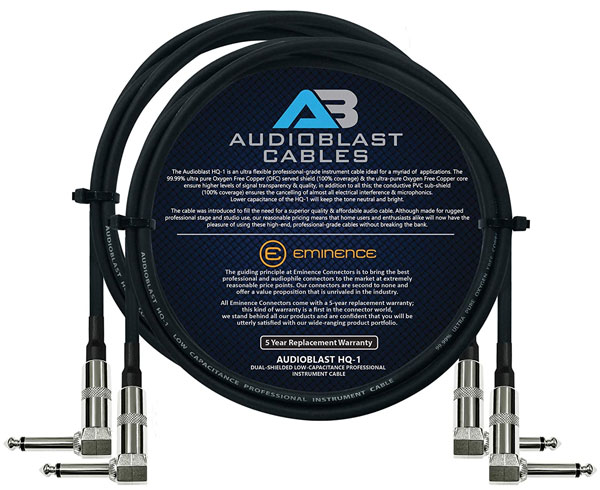Selecting the right patch cables for connecting the stompboxes on your pedalboard is essential if you want to ensure that you minimize noise issues and achieve optimal sound quality. Patch cables are often overlooked, because on the surface it may seem that there’s very little difference between the different options on the market.
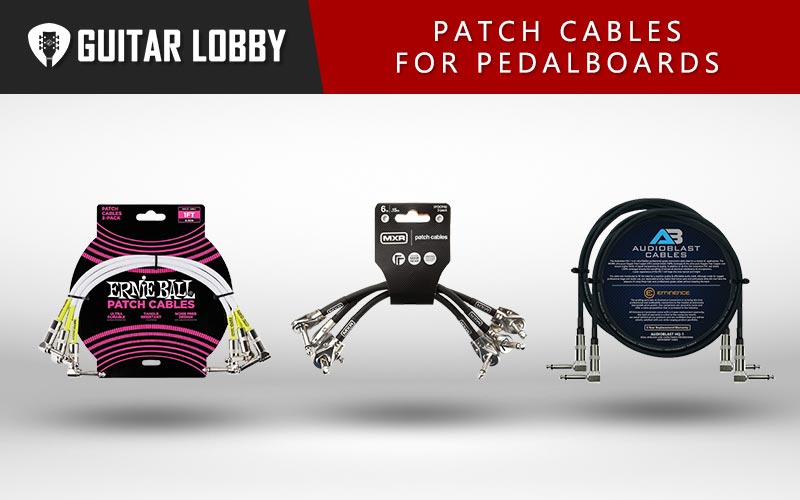
However, upon further inspection, it is clear that the quality, durability, and performance of patch cables for your pedalboard vary depending on which ones you choose. In this definitive guide, I’ll highlight a selection of the very best patch cables that you can use to connect the pedals in your signal chain.
| Name of Product | Image of Product | Description | Price Range | Full Review |
|---|---|---|---|---|
| 1. Ernie Ball Stage and Studio (Best Value) | 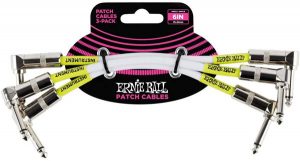 | Number of Cables: 3 Angle: Right Angle | $20 | Read Full Review Below |
| 2. Hosa IRG-600.5 (Best Overall) | 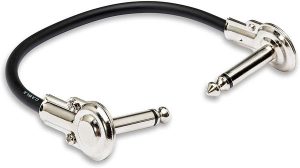 | Number of Cables: 6 Angle: Right Angle | $30 | Read Full Review Below |
| 3. Ernie Ball Flat Ribbon (Editor's Choice) | 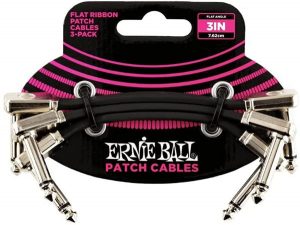 | Number of Cables: 3 Angle: Right Angle | $25 | Read Full Review Below |
| 4. Donner Guitar Patch Cables (Best Under $20) | 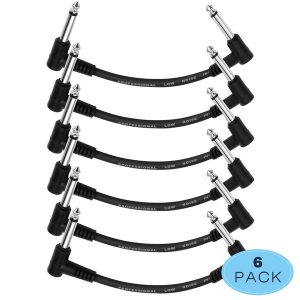 | Number of Cables: 6 Angle: Right Angle | $20 | Read Full Review Below |
| 5. Fender Professional Cable (Best Under $15) | 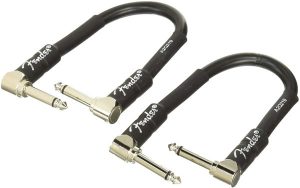 | Number of Cables: 2 Angle: Right Angle | $15 | Read Full Review Below |
| 6. Audioblast Eminence HQ-1 | 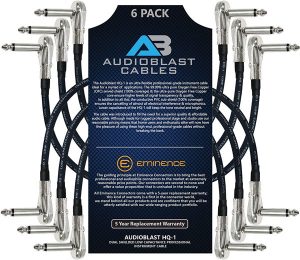 | Number of Cables: 6 Angle: Right Angle | $20 | Read Full Review Below |
| 7. D’Addario Planet Waves Classic Series | 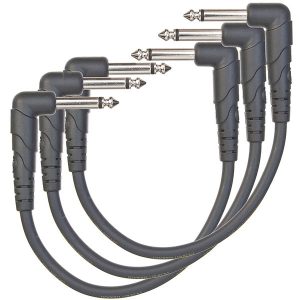 | Number of Cables: 3 Angle: Right Angle | $15 | Read Full Review Below |
| 8. Dunlop MXR Right Angle Pancake | 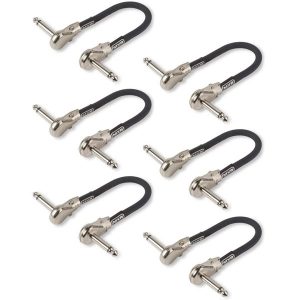 | Number of Cables: 6 Angle: Right Angle | $25 | Read Full Review Below |
| 9. MXR Patch Cables | 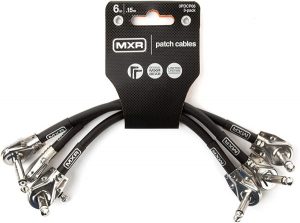 | Number of Cables: 3 Angle: Right Angle | $15 | Read Full Review Below |
| 10. Timesetl Guitar Patch Cables | 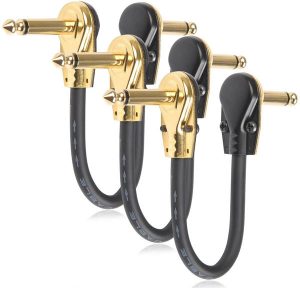 | Number of Cables: 3 Angle: Right Angle | $10 | Read Full Review Below |
| 11. WBC Mogami | 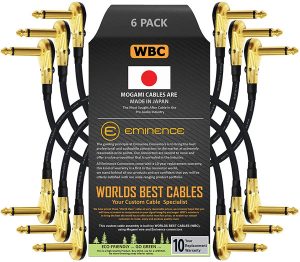 | Number of Cables: 6 Angle: Right Angle | $35 | Read Full Review Below |
| 12. Donner Guitar Patch Cables | 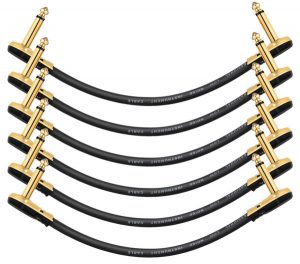 | Number of Cables: 6 Angle: Right Angle | $25 | Read Full Review Below |
| 13. Miracle Sound Guitar Patch Cable | 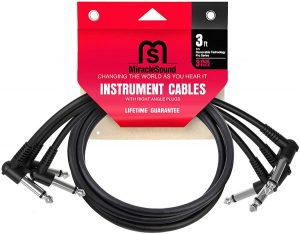 | Number of Cables: 3 Angle: Right Angle | $10 | Read Full Review Below |
| 14. Fender Custom Shop Performance Series | 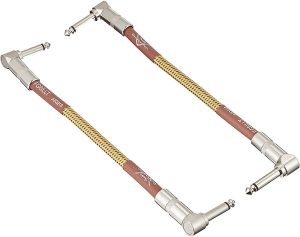 | Number of Cables: 2 Angle: Right Angle | $25 | Read Full Review Below |
| 15. Augith Guitar Patch Cables | 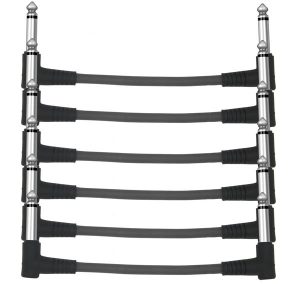 | Number of Cables: 6 Angle: Right Angle | $15 | Read Full Review Below |
| 16. Honest Kin Flat Low Profile | 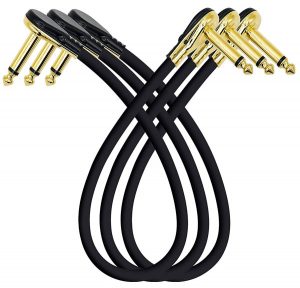 | Number of Cables: 3 Angle: Right Angle | $15 | Read Full Review Below |
| 17. Audioblast 2ft HQ-1 | 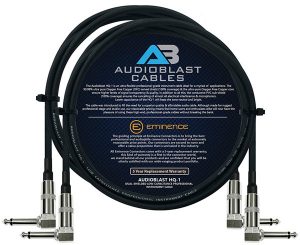 | Number of Cables: 2 Angle: Right Angle | $10 | Read Full Review Below |
Here Are the Best Pedalboard Patch Cables
1. Ernie Ball Stage and Studio (Best Value)
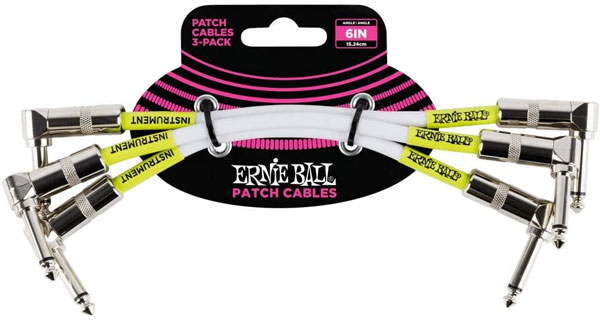
| Estimated Price | $20 |
| Number of Cables | 3 |
| Angle | Right Angle |
| Length | 6” |
My Review: Ernie Ball is best known for its industry-leading selection of guitar and bass strings. I’ve used their products on many occasions, so when I discovered that they also produce patch cables for pedalboards I was eager to find out whether they lived up to the reputation of their strings.
One of the main qualities which contribute to the popularity of Ernie Ball’s strings is durability. The Stage and Studio patch cables are also highly durable, largely as a result of the high-quality materials from which they are composed.
To ensure that the Stage and Studio patch cables will stand up to the inevitable rigors of heavy usage on a pedalboard, Ernie Ball has used copper material which is almost completely free from oxygen. This method prevents corrosion and therefore improves the longevity of the patch cables.
After testing these Ernie Ball Stage and Studio patch cables, one of the qualities which set them apart from other offerings on the market is their flexibility. There’s no danger of these cables getting tangled, and this ultimately improves the sound quality that they produce.
Who is this best suited for: If you’ve got a relatively small number of effects pedals on your pedalboard and you’re looking for the best quality patch cables to connect them, I’d highly recommend the Ernie Ball Stage and Studio cables.
Bottom Line: If you’ve ever used a set of Ernie Ball Super Slinky’s or any of their other exceptional strings, you’ll know that this manufacturer designs their products meticulously. The Stage and Studio Patch Cables are another example of their attention to detail. With a natural voicing that allows effects pedals to transmit their signals smoothly and a highly robust design, these patch cables are amongst the best on the market.
2. Hosa IRG-600.5 (Best Overall)
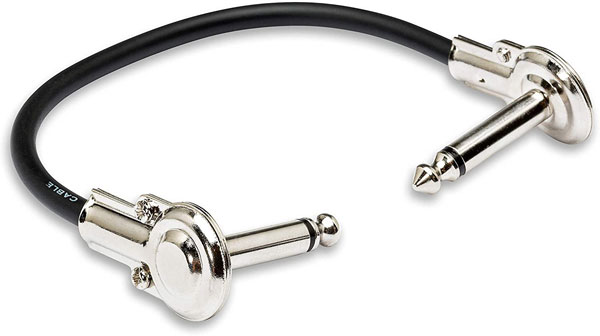
| Estimated Price | $30 |
| Number of Cables | 6 |
| Angle | Right Angle |
| Length | 6″ |
My Review: The IRG-600.5 patch cables by Hosa combine quality with quantity. This manufacturer has been on my radar for a while now, and I’ve been impressed by their extensive range of cables for instruments and audio systems.
It’s very easy to overlook the impact that patch cables have on the sonic performance of effects pedals, but I’ve found that there are notable differences between a good quality set and a sub-par set. After testing these Hosa patch cables, I would put them into the former category.
One of the things I found most useful about the IRG-600.5 patch cables was their flexibility. Some patch cables compromise on strength in place of flexibility, but Hosa has proven that this doesn’t have to be the case. Right off the bat, I found the robust, low-profile design of the cables that made them stand out in a crowded market.
After doing some additional research into the specifications of the cables, I found that a large contributor to their sound quality and low-noise performance was the specially-designed OFC spiral shield, which rejects both RFI and EMI, thus allowing effects pedals to work without any electrical hum or buzzing sounds tarnishing the signal.
Who is this best suited for: With six high-quality patch cables included in this set, Hosa’s IRG-600.5s are great value for money. Consequently, I’d recommend them to guitarists, bassists, keyboardists, or vocalists who have a medium-sized pedalboard and need enough cables to link all of their stompboxes together.
Bottom Line: Combining low-noise performance, strength, and malleability, these right-angled patch cables by industry heavyweights Hosa are a great choice. They’re ideal for hooking up effects pedals on a pedalboard that is a little tight for space and can be manipulated to fit into small gaps thanks to their flexible design.
3. Ernie Ball Flat Ribbon (Editor’s Choice)
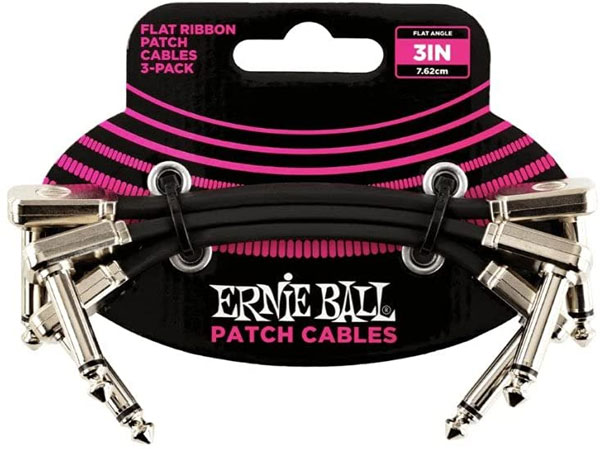
| Estimated Price | $25 |
| Number of Cables | 3 |
| Angle | Right Angle |
| Length | 3″ |
My Review: The term ‘roadworthy’ is often used too generously in my opinion, but I can safely say that these Ernie Ball Flat Ribbon patch cables are wholly deserving of it. Ideal for all pedalboards regardless of size and extensiveness, these cables combine durable construction with a clean, transparent tone.
One of the key aspects of the Flat Ribbon patch cables is their dual-shielded design. I was impressed by the lack of noise they produced, even when using them with high-gain pedals that are prone to producing hiss and crackles if used with low-quality patch cables.
Tonally, Ernie Ball is one of the leading patch cable producers. The Flat Ribbon set produces crisp and clear highs, with a tight midrange output and expressive harmonics across the frequency range of a guitar, keyboard, or bass.
Who is this best suited for: Tone-purists will find the Ernie Ball Flat Ribbon patch cables to be a perfect match for their high expectations. These cables are designed to stand the test of time and produce the cleanest signal possible.
Bottom Line: Ernie Ball is renowned for going the extra mile when building and designing their products, so it should come as no surprise that their Flat Ribbon patch cables perform to a very high standard. Dual shielded and made from 99.95% oxygen-free copper, they are both resistant to corrosion and sonically pleasing.
4. Donner Guitar Patch Cables (Best Under $20)
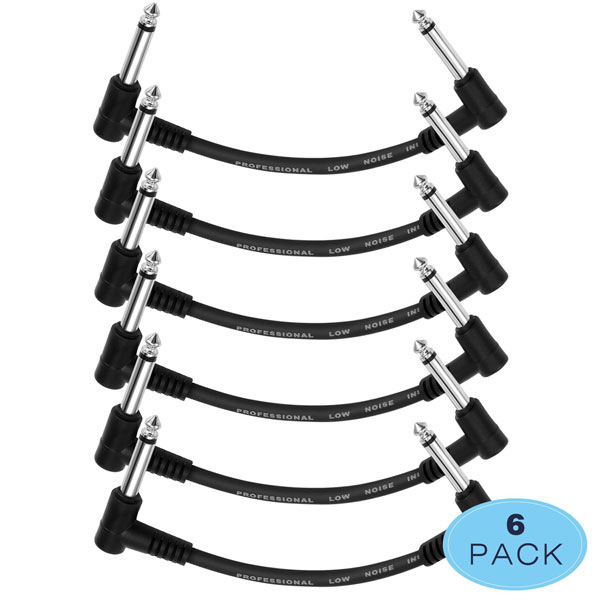
| Estimated Price | $20 |
| Number of Cables | 6 |
| Angle | Right Angle |
| Length | 6″ |
My Review: Since Donner burst onto the music scene almost a decade ago, their rise to prominence has been remarkable. I’ve enjoyed watching their range of equipment expand from simplistic and affordable stompboxes to complex multi-FX units, instruments, and cables.
Donner’s Guitar Patch Cables are both affordable and reliable, thanks to the manufacturer’s design. As soon as I plugged them into the effects on my pedalboard, I could hear the sound quality that is produced by their high fidelity signal transmission.
At 6 inches, these patch cables are the perfect length to be used on a crowded pedalboard. Furthermore, they have a robust connector with a bendable cable, which I found to be perfect for tucking away so that they don’t impede the use of the footswitches on effects pedals.
Who is this best suited for: If you’re looking for a set of patch cables which are both affordable and versatile, this Donner set is worthy of consideration. They blend a robust connector design with a flexible cable design, which makes them ideal to be squeezed into the right gaps on a pedalboard.
Bottom Line: I’ve found that 6 inches is the optimal length for patch cables, simply because it allows you to position your effects with enough space between them to use the footswitches comfortably, whilst maximizing the space available on the pedalboard. The Donner Guitar Patch Cables are shielded for noise rejection and designed to keep your tone pure and unaltered when using your pedals. Overall, I’d say that these are the best patch cables for pedalboards under $20.
5. Fender Professional Cable (Best Under $15)
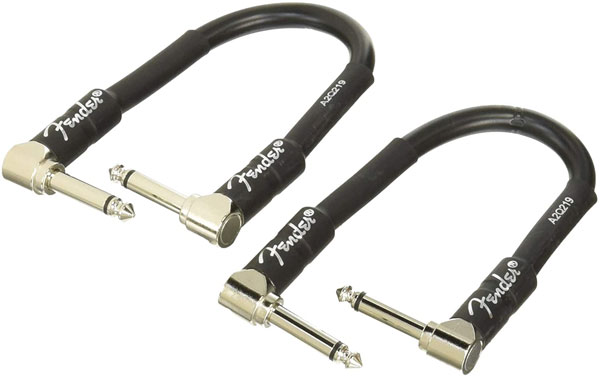
| Estimated Price | $15 |
| Number of Cables | 2 |
| Angle | Right Angle |
| Length | 6″ |
My Review: It’s a testament to Fender’s reputation that every piece of equipment I come across which has its iconic logo imprinted on it, I expect big things from. As a huge fan of their instruments and amplifiers, I could be accused of being a little biased toward this legendary American manufacturer.
Putting my bias aside, the Fender Professional Cable set is amongst the best patch cables money can buy. Although there are only two cables included in the set, they’re built to such a high standard that they are very likely to be a long-term investment.
I was very impressed by the strength and durability of the nickel-plated connector ends. In addition to their undeniable physical qualities, once I plugged them into my pedals I was taken aback by the crisp transmission of the signal which they facilitated.
The standout quality of these Fender Professional patch cables is their classy appearance. There’s something about the Fender logo which makes a product stand out, and when it is combined with a black PVC material, it adds a distinguished visual element to a pedalboard.
Who is this best suited for: Musicians who love Fender as I do will likely be drawn to these Professional patch cables. Due to there only being two in a set, I’d recommend them to those who are beginning to build up their pedal collection slowly and don’t require a large quantity just yet.
Bottom Line: With high-quality connectors plated with nickel and a thick, 8mm wire jacket coating the inner components of the cables, this Fender set performs wonderfully. They feature a right-angled design, and prevent twisting or kinging due to the robustness of their spiral shielding.
6. Audioblast Eminence HQ-1
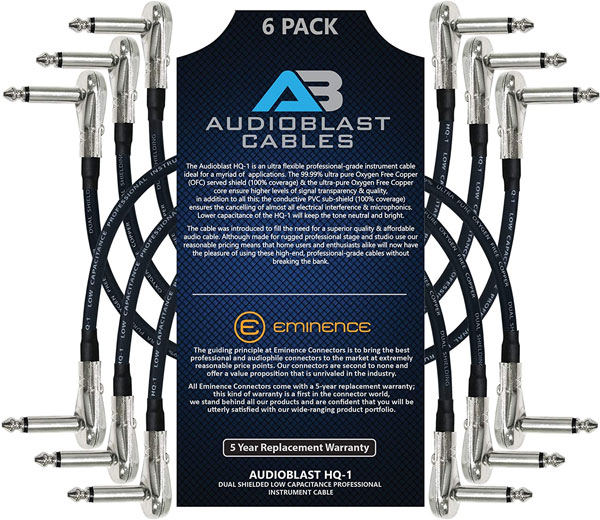
| Estimated Price | $20 |
| Number of Cables | 6″ |
| Angle | Right Angle |
| Length | 6″ |
My Review: Flexibility is a key quality that every musician needs when using patch cables on their pedalboard. The Audioblast Eminence HQ-1 patch cables have this quality in abundance, and what I found even more impressive about them was that they also possess undeniable durability.
When searching for the best patch cables, one of the things I specifically looked for was signal transparency. This is vital for musicians, as it ensures that even the most transformative effects on their pedalboard sound clear and powerful.
I was therefore pleased to discover that the Audioblast Eminence HQ-1 patch cables possess an oxygen-free copper core, which when paired with the conductive PVC sub shield creates the perfect pathway for the signal to run through.
Who is this best suited for: With 6 patch cables included in the Audioblast Eminence HQ-1 set, I believe that it is best suited to musicians who are looking for consistency throughout their pedalboard. These cables are high-strength, so if you are likely to use your effects regularly you can rest assured that they won’t buckle under pressure.
Bottom Line: The Audioblast Eminence HQ-1 patch cables have all of the necessary qualities required for linking pedals within your signal chain. They keep noise issues to a minimum thanks to their high-quality inner components, and the addition of staggered double-boots ensures a solid connection.
7. D’Addario Planet Waves Classic Series
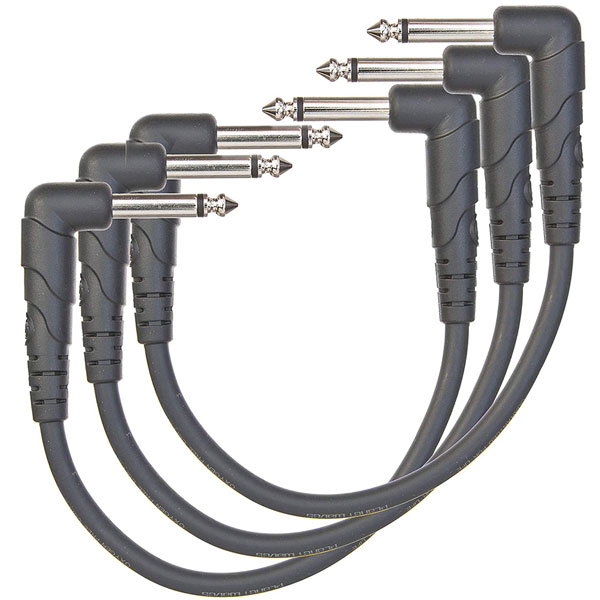
| Estimated Price | $15 |
| Number of Cables | 3 |
| Angle | Right Angle |
| Length | 6″ |
My Review: Planet Waves was created as a side project of world-renowned string and cable manufacturers, D’Addario. If you’ve ever used D’Addario products before, I’m sure you’ll be aware of their quality.
The Planet Waves Classic Series patch cables are an embodiment of strength and sound quality. Right off the bat, I was very impressed by the way these cables could be easily positioned on the pedalboard, whether they needed to be squeezed into tight spaces or stretched across a 6-inch distance from the pedal to the pedal.
Sonically, these patch cables are flawless. After checking out the specs, I found that this is largely a result of D’Addario using 90% spiral shielding, which keeps any handling noise issues at arm’s length. The right-angle design of these cables is convenient and ensures that the connectors aren’t subjected to too much movement, improving their longevity.
Who is this best suited for: Audiophiles who are on a mission to ensure that their signal strength and quality are as good as they possibly can be will love the Planet Waves Classic Series patch cables. Built using the highest quality components, these cables produce no unwanted noise and maintain the strength of your effects.
Bottom Line: The D’Addario Planet Waves brand is considered to be one of the best in the field of instrument cables, and this set of patch cables further reinforces their reputation. With low-noise performance, a high-strength design, and a transparent sound, they are a great choice for all musicians.
8. Dunlop MXR Right Angle Pancake
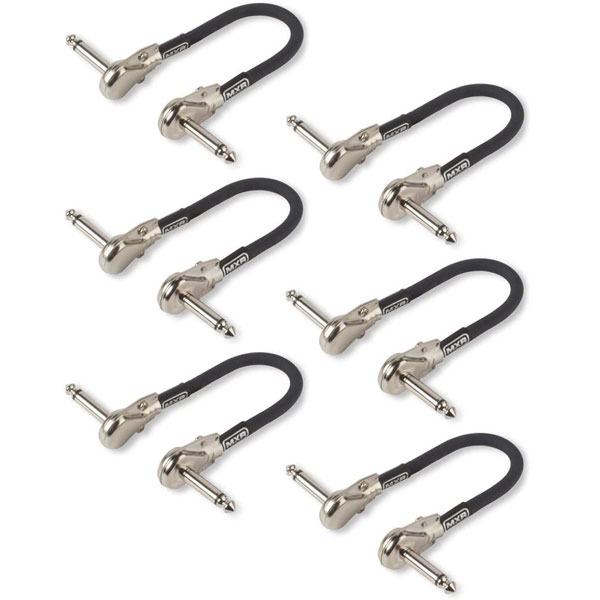
| Estimated Price | $25 |
| Number of Cables | 6 |
| Angle | Right Angle |
| Length | 6″ |
My Review: MXR’s Right Angle Pancake patch cables offer a combination of tonal transparency and roadworthy build quality. After testing these cables, I instantly noticed the lack of interference from my signal chain, which made the effects sound clearer and more defined.
I also found that the outer PVC layer struck an ideal balance between being pliable enough to fit into tight gaps on my pedalboard, and having the strength to stay firmly in place without twisting.
After doing some research to find out how MXR managed to prevent noise issues and keep the signal so clear, I discovered that they used a spiral shielding technique to achieve this.
Who is this best suited for: With six high-quality patch cables included in this set, they’re a great choice for guitarists looking for consistency throughout their pedalboard.
Bottom Line: MXR are renowned for ensuring that their products are high-functioning, whether it is their unique stompboxes or patch cables. This set uses oxygen free copper material for ultimate sound quality, and the connectors are secured to promote longevity.
9. MXR Patch Cables
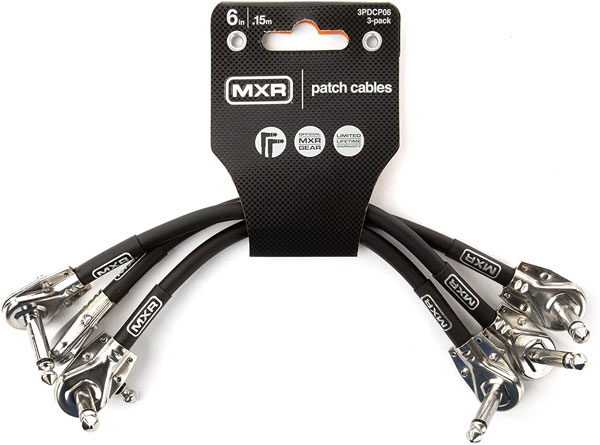
| Estimated Price | $15 |
| Number of Cables | 3 |
| Angle | Right Angle |
| Length | 6″ |
My Review: At Guitar Lobby, we’re very fond of MXR products. Perhaps best known for their fantastic ‘Carbon Copy’ delay pedal, the Dunlop-owned manufacturer also produces a range of high-end instrument cables including this set of six-inch patch cables.
The first thing I noticed about these cables was the durability of their outer layer. Not only does the thick material prevent kinks and tangles from occurring on your pedalboard, but it also ensures that the inner wires and components are fully protected from wear and tear.
In terms of their impact on the sound quality of your signal chain, the MXR patch cables use a specially designed OFC spiral shield to minimize interference. This allows pedals to function clearly without any noise issues diminishing the quality of an instrument’s signal.
Who is this best suited for: The MXR Patch Cables are a great match for guitarists, bassists, or any other musician whose priority is keeping their pedalboard tidy. Their strong construction ensures longevity, and they’re flexible enough to be used in tight spaces if the need arises.
Bottom Line: Like all MXR products, these patch cables are built using only the finest components to promote crisp sound quality. They feature a flat, right-angled connector design which reduces tension on the ¼ inch jack plugs.
10. Timesetl Guitar Patch Cables
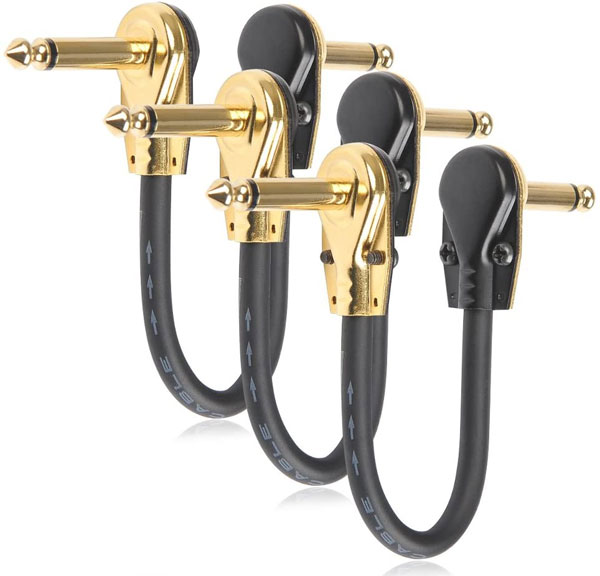
| Estimated Price | $10 |
| Number of Cables | 3 |
| Angle | Right Angle |
| Length | 6″ |
My Review: Before encountering the Timesetl Guitar Patch Cables, I was admittedly skeptical about gold-played connectors. However, these cables have convinced me that this is more than just a marketing tactic.
These patch cables are constructed from copper material which contains no oxygen. The purpose of this design is that it prevents them from wearing out over time due to corrosion, which also improves their sonic capabilities.
One of the best things I discovered about these Timesetl Patch Cables is that you can easily remove the connectors using a Phillips screwdriver. This means that if one of the connectors becomes faulty further down the line, you can replace them without any hassle, meaning you won’t need to invest in another set of cables any time soon.
Who is this best suited for: If you’re likely to use your pedalboard regularly and therefore need patch cables that can handle heavy usage, there are few better options on the market than this durable set by Timesetl.
Bottom Line: Timesetl has included three high-performance patch cables in this set, with gold-plated connectors in the right angle, pancake design. They use a multi-shielding process to ensure minimal noise interference, and the cables are both resistant to temperature changes and waterproof, providing musicians with peace of mind when using them.
11. WBC Mogami
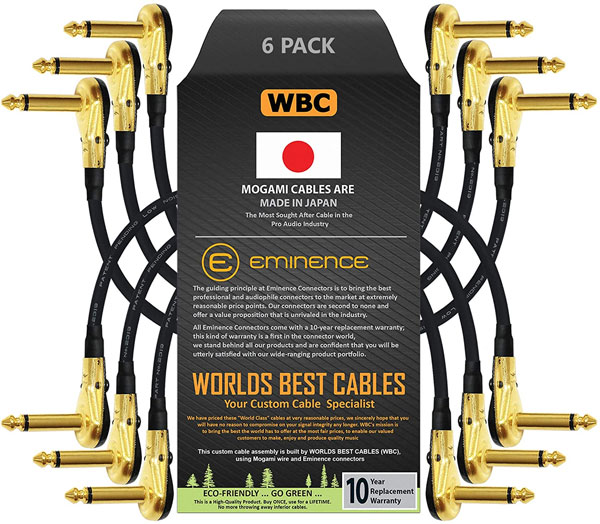
| Estimated Price | $35 |
| Number of Cables | 6 |
| Angle | Right Angle |
| Length | 6″ |
My Review: WBC, or ‘World’s Best Cables’ had better be good to live up to their bold name! Thankfully, I found these patch cables to deliver on their promise of promoting maximum signal strength, sound quality, and robustness.
The connectors are gold-plated and of the pancake variety. Another thing I found impressive about them is their custom-built inner wiring, which is made using the revered Mogami 2319 wire. There’s a unique quality about these patch cables which is probably a result of WBC’s undeniable attention to detail.
Who is this best suited for: If you require a significant number of patch cables to connect the various effects on your pedalboard but don’t want to compromise on quality, this set of 6 cables by WBC is worth considering.
Bottom Line: Custom-built to maximize sound quality and durability, the WBC Mogami cables deliver on all fronts. The Mogami wire is highly sought after by musicians and sound engineers, as it has a reputation for producing clean-sounding signals with little to no interference.
12. Donner Guitar Patch Cables
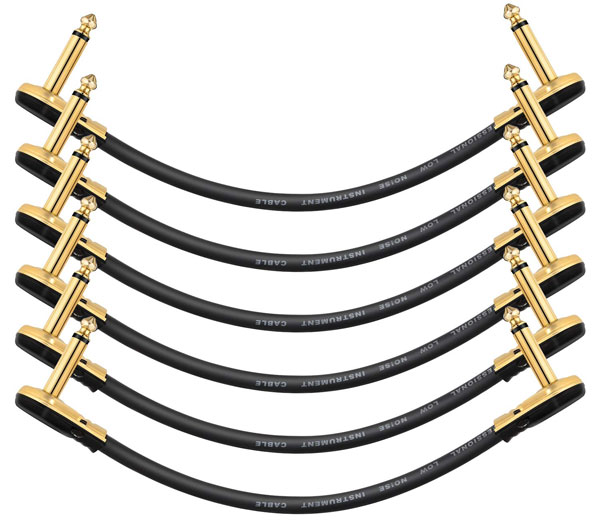
| Estimated Price | $25 |
| Number of Cables | 6 |
| Angle | Right Angle |
| Length | 6″ |
My Review: Donner returns to our list, this time with their set of six gold-plated patch cables. Affordable and versatile, these cables ensure that the mid-range and treble frequencies produced by effects pedals are preserved.
When Donner constructed these patch cables, they used a rare solder blend that includes a small amount of silver. This ensures that the connectors won’t come loose very easily. The material used for the outer coating is resistant to heat, which also improves the longevity of these patch cables and prevents them from wearing out over time.
Who is this best suited for: The Donner Guitar Patch Cables are a great choice for musicians who are shopping on a budget, but still want to ensure that their effects on their pedalboards work to their maximum capacity.
Bottom Line: With their noiseless design and solid construction, one would expect that the Donner Guitar Patch Cables would come with a larger price tag than they do. This set of six cables made with copper shielding have an impressively low capacitance, which promotes noise rejection and ensures tonal clarity.
13. Miracle Sound Guitar Patch Cable
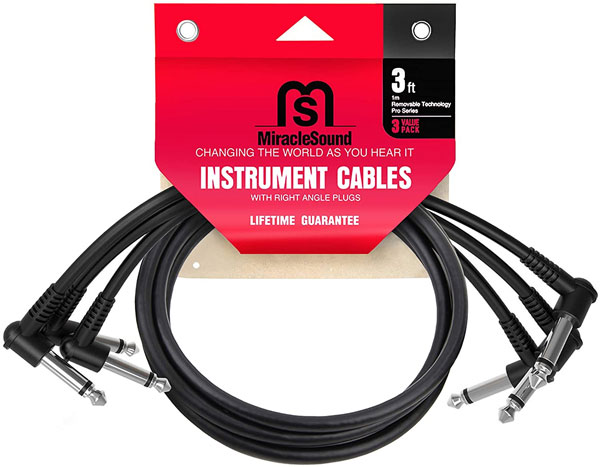
| Estimated Price | $10 |
| Number of Cables | 3 |
| Angle | Right Angle |
| Length | 3″ |
My Review: Miracle Sound’s Guitar Patch Cables first came to my attention due to their length. At 3ft, these are amongst the longest patch cables you can get your hands on. They’re essentially guitar cables with patch cable connectors installed on the ends.
The advantage of using longer patch cables is that it allows you to connect devices that are spread out on your pedalboard. Perhaps you’re interested in finding out which sounds are produced when you use alternative signal chain positions, and would rather quickly make the connection rather than needing to reposition all of the stompboxes on your pedalboard. With these extra long patch cables, you can do this easily and quickly.
Who is this best suited for: If your pedals are distanced from one another on your pedalboard, the 3ft patch cables by Miracle Sound are a great option. These cables afford you more freedom and flexibility when setting up the effects in your signal chain.
Bottom Line: With their extensive length and reliable sonic performance, the Guitar Patch Cables by Miracle Sound excel in all areas. The manufacturer has used high-quality shielding to keep noise issues at bay, and the cables are designed to last for many years.
14. Fender Custom Shop Performance Series
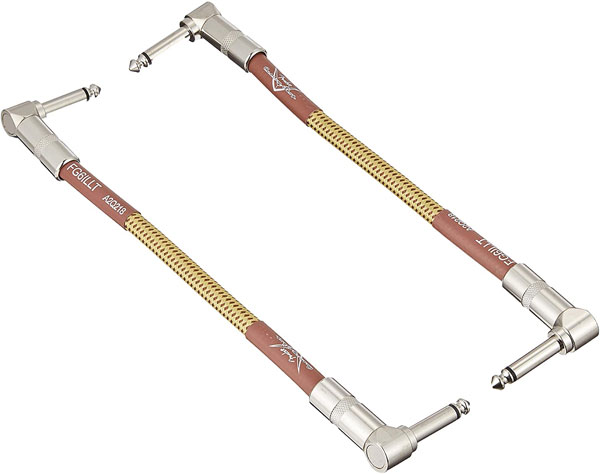
| Estimated Price | $25 |
| Number of Cables | 2 |
| Angle | Right Angle |
| Length | 6″ |
My Review: Fender’s Custom Shop Performance Series patch cables are unique in aesthetics and performance. With reinforced connectors that are made from 95% oxygen-free copper, these cables are robust enough to handle the inevitable wear and tear that musicians subject them to.
As with most Fender products, the manufacturer has gone the extra mile when designing this pair of patch cables. The jacket is made from high-density tweed which has been braided and has a diameter of 8mm. This reduces noise and ensures that the signal from the effects pedals is transmitted as accurately as possible.
Who is this best suited for: If you need a small number of patch cables to link up pedals in your signal chain, this Fender set is a suitable choice.
Bottom Line: Pliable and strong, the Fender Custom Shop Performance Series patch cables ensure that tangles, kinks, and noise issues are a thing of the past. These cables are composed of highly durable materials and the connectors are extremely roadworthy. These are easily some of the best pedalboard patch cables on the market right now.
15. Augith Guitar Patch Cables
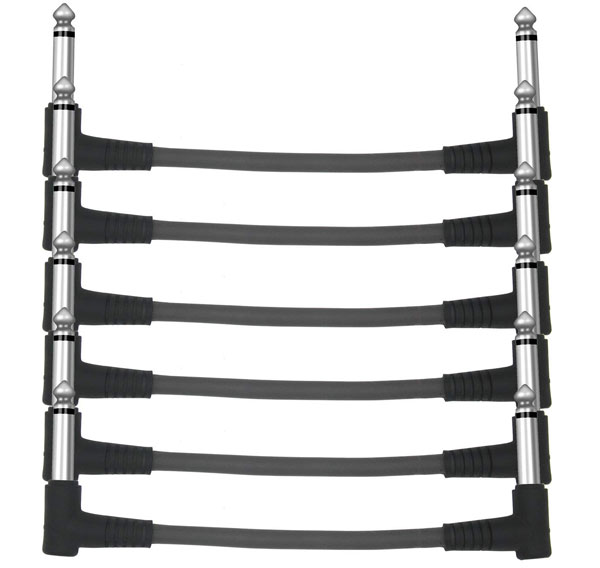
| Estimated Price | $15 |
| Number of Cables | 6 |
| Angle | Right Angle |
| Length | 6″ |
My Review: After testing the Augioth Guitar Patch Cables, I was very impressed by their capabilities. Initially, I wasn’t expecting a great deal from these cables, as they are very affordable and come in a set of six.
However, I found that they perform to the standard you’d expect from a more expensive set of patch cables, thanks to the manufacturer’s construction methods. The outer coating of the cables is malleable, but also robust enough to stay in the desired position on your pedalboard. Additionally, these cables are extremely lightweight so they won’t add unnecessary weight to your board.
Who is this best suited for: Due to their affordability, I would highly recommend the Augioth Guitar Patch Cables to any musician who is looking for a quality option at a low price.
Bottom Line: The Augioth Guitar Patch Cables set includes a total of six high-strength cables. Coated in a soft, durable jacket, the cables are resistant to kinks, twists, and tangles, and sonically they preserve the quality of the signal as it moves through the chain.
16. Honest Kin Flat Low Profile
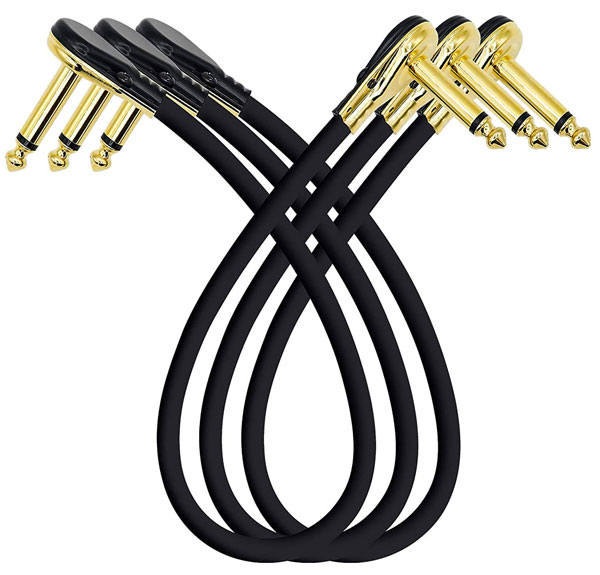
| Estimated Price | $15 |
| Number of Cables | 3 |
| Angle | Right Angle |
| Length | 12” |
My Review: When inspecting the specifications of the Honest Kin Flat Low Profile patch cables, I was impressed by the quality of the materials the manufacturer has used. For low-noise performance, they opted for 22AWG copper wire which is free of oxygen and improves the longevity of the cables.
I then discovered that that the cables are coated in five protective layers. This may seem like overkill, but it ensures that the inner wires are fully shielded, and therefore not prone to interference or other electrical noise issues.
Who is this best suited for: Regardless of your playing style or the effects you use on your pedalboard, the Honest Kin Low Profile patch cables are a worthy addition to your rig.
Bottom Line: These patch cables boast all of the necessary qualities to connect the effects on your pedalboard. They’re flexible, durable, and great for isolating noise.
17. Audioblast 2ft HQ-1
| Estimated Price | $10 |
| Number of Cables | 2 |
| Angle | Right Angle |
| Length | 2″ |
My Review: Compared to the majority of patch cables featured on this definitive list, the Audioblast HQ-1s are significantly longer. At 2ft. the cables can stretch across those awkwardly long distances on your pedalboard.
I’ve often experienced the inconvenience of trying to stretch patch cables from one pedal to another, only to find that the standard 6-inch length doesn’t quite cut it. Thankfully, with these low-noise, all-black Audioblast cables, you can easily experiment with different pedal orders without needing to uproot your stompboxes until you’re sure that you like the new combination.
Who is this best suited for Due to their extensive length I would recommend the Audioblast 2ft HQ-1 patch cables to musicians who enjoy experimenting with new pedalboard layouts. These cables save you having to move your pedals before you’ve tested the different orders, which is invaluable for those who enjoy coming up with new sounds and tones.
Bottom Line: Audioblast builds all of their patch cables to a very high standard, with conductive PVC shields and oxygen-free copper ensuring optimal sound quality. This set is also likely to stand the test of time, with sturdy connectors and a rugged design.
Choosing the Right Patch Cables For Your Pedalboard
All musicians, whether they play guitar, bass, keyboards, vocals, or another amplified instrument use effects pedals to deliberately shape their sound and tone. To get the best possible results, it’s important to use the best possible instrument cables, power supplies, and of course, patch cables.
In the remaining sections of this guide, I’ll provide you with all of the information you need to make the right decision when choosing which patch cables you should use to connect the effects on your pedalboard.
The Purpose of Guitar Patch Cables
Patch cables are an integral part of a musician’s signal chain. Using the electric guitar as an example, the signal starts when the musician makes contact with the strings. This is then received by the pickups, which convert it into an electrical signal.
The signal then travels through the instrument cable, and into the guitarist’s first stompbox on their pedalboard. Patch cables are used to transmit the signal to the pedal’s inputs, and from their outputs, until eventually the signal is sent from the final pedal in the chain to the amplifier where it is projected through one or multiple speakers.
Patch cables are essentially smaller-sized jack cables, but they are designed especially to be squeezed into tight spaces on the pedalboard. They are an essential component in the signal chain, as without them there would be no way for the signal to pass through the effects to reach the amplifier.
Why Patch Cable Quality Matters
Musicians are aware of the impact that the quality of their instrument, amplifier, and effects pedals have on their tone. However, they often underestimate the importance of using good quality cables to transmit their signal throughout the chain.
This is understandable, as patch cables aren’t quite as exciting as fancy stompboxes, tube amplifiers, or instruments. Nevertheless, for the aforementioned pieces of equipment to reach their fullest potential, they must be paired with patch cables that allow them to flourish.
The qualities that make a good quality patch cable include durability, resistance to tangles, kinks, and twisting, the ability to minimize interference through shielding, a low-noise output, and of course flexibility for keeping the cables tidy on the pedalboard.
To ensure that their patch cables tick each of those boxes, manufacturers use a variety of specific components, design methods, materials, and techniques.
Organizing Your Pedalboard
When assembling the pedals on your pedalboard, it’s important to organize them in the most efficient way possible. This will vary depending on each musician’s preferences, but there are some measures you can take to keep your pedalboard organized.
Patch cables should ideally be tucked away discreetly so that they don’t impede the use of your pedals. If the cables are messy, they may get in the way of the footswitches on your pedal, which could result in mistakes when trying to turn your effects on or off.
Effects pedals need to be ordered so that the patch cables can easily reach their inputs and outputs. If you’re using Velcro or some other method to attach the pedals to your pedalboard, it’s a good idea to connect them using your patch cables before you secure them to make sure they can easily reach the next pedal in the chain.
Patch Cables & Signal Chain Placement
Another key aspect of setting up the effects on your pedalboard is deciding how to position them in your signal chain. This requires careful consideration, as the effects that the pedals produce are largely influenced by the order in which they are placed.
Once you’ve decided on the order of your pedals, you can then make sure the patch cables you use are long enough and suitable to form the connections.
Although most musicians agree that there are certain signal chain orders which should be followed most of the time, there is no ‘right or wrong way to do this. It ultimately comes down to your personal preference, and the results you’re aiming for.
Conventionally, the signal chain is almost always started with a tuner pedal. Then come any dynamic pedals, such as compressors, EQ, boost pedals, or limiters. Next, it’s common to place a wah pedal, which is followed by distortion, overdrive, and fuzz.
After distortion-based effects, many musicians choose to place their modulation pedals. These include octave and pitch-shifters, phasers, flangers, vibrato, tremolo, and chorus pedals. Finally, the signal chain is commonly concluded with reverb and delay pedals.
Pre-planning the positions of your pedals is essential, as it allows you to ensure that you choose suitable patch cables to form the connections.
Patch Cable Dimensions
The majority of patch cables are around 6 inches in length. This is the standard length because it is adequate for reaching the inputs and outputs of your pedals, but not overly long so that the cables easily get in the way or become tangled.
There are longer patch cables available, and these are useful if you need to form a connection between two pedals that are further apart on your pedalboard. Ideally, shorter patch cables should be used where possible, as this will keep your pedalboard tidier and more organized.
By pre-planning the order of your pedals on your pedalboard, you can make sure that you choose patch cables that are the ideal length to form the connections.
Cable Length, True Bypass & Buffered Pedals
On the topic of patch cable length, something that needs to be considered is whether you’re using buffered or true-bypass pedals, or a mixture of the two.
The reason that this is important is that buffered and true bypass pedals are best suited to different cable lengths within the signal chain. For example, if your total cable length surpasses 18.5 ft, you can’t rely solely on true bypass pedals as the signal strength starts to diminish.
Buffered effects pedals are better suited to longer cable lengths. It’s also possible to combine buffered and true bypass pedals, but it’s advised that if you choose to do this, you should begin the signal chain with a buffered device as this will boost the signal and ensure that its strength is maintained as it travels through the patch cables in your signal chain.
Patch Cables & Pedal Power
To provide your effects pedals with the power they need to work, the most reliable method is to use a power supply unit (PSU). These devices output the voltage through power cables and can power multiple pedals simultaneously.
Power cables and patch cables tend to get tangled up and in each other’s way if they are not intentionally positioned. The power input of each pedal differs in terms of its position, so you’ll need to ensure that the lead can be tucked away otherwise it may impede the position of your patch cables.
Using a PSU allows you to leave all of the pedals in your signal chain plugged in so that you don’t need to waste time reconnecting them when you next use your pedals. Likewise, patch cables allow you to leave the pedals connected permanently.
If you choose to use batteries to power your pedals, you should be aware that leaving the patch cables connected to the pedal’s output will cause the battery to be drained even though you are not using the pedal.
Recording The Effects on Your Pedalboard
Another advantage of having high-quality patch cables is that they allow you to record the effects on your pedalboard with ease. Using lesser-quality patch cables will likely result in noise issues being picked up in your recordings, which is something most musicians want to avoid at all costs.
You can record the effects on your pedalboard directly by sending the output into an audio interface. The patch cables allow you to use multiple effects at once if the need arises, and when no effects are activated you’ll be left with a recording of your clean tone.
Alternatively, you can send the output from your pedalboard into an amplifier and record the sound that comes out of the speaker by placing a microphone in front of it. I’d recommend experimenting to find out which method best suits the selection of pedals you have at your disposal.
Patch Cables, Inputs & Outputs
Once you’ve decided on the positions of the pedals in your signal chain, and placed them on your pedalboard, you then need to form the connections with the patch cables. This should be straightforward, but it can get a little confusing if there are multiple inputs and outputs on a pedal.
The simplest way to build your signal chain is to connect one end of the patch cable to the output from a pedal, then connect the other end to the input on the next pedal in the chain.
If a pedal has two outputs, you can use the second one to split the signal if this would be beneficial for you. This allows you to send the dry signal to a separate amplifier, while the wet signal is sent to the next pedal in the chain.
Shielded Cables & Interference
One common technique used by patch cable manufacturers is shielding. This is where a layer or multiple layers are formed around the inner wire of the patch cable, with the aim of preventing interference and improving overall signal strength.
Most patch cables use some form of shielding, but there are different ways of achieving it. It’s a good idea to check the specs of the patch cables you’re interested in purchasing to ensure that they are shielded so that you don’t get interference when using your pedals.
Quantity and Quality
As musicians, we often lean towards quality over quantity. This makes sense when considering which instruments, amplifiers, or effects to purchase, as choosing lesser quality devices for the sake of getting more for our money will ultimately be detrimental to our sound.
However, when it comes to patch cables, the key is to look for both quality and quantity. If you need eight patch cables for your pedalboard, there’s no harm in choosing a set that includes more but perhaps doesn’t offer the fancy perks of a more expensive patch cable.
Summary
Patch cables may not be the most exciting items you’ll purchase when setting up your pedalboard, but they are vital nonetheless. Choosing a good quality set will allow your pedals to perform to the very best of their abilities.
Hopefully, after reading this guide you’ve gained the knowledge required to choose the ideal patch cables for your pedalboard. Now you can enjoy the sonic and tonal benefits that they produce!

My name is Chris and I’ve had a passion for music and guitars for as long as I can remember. I started this website with some of my friends who are musicians, music teachers, gear heads, and music enthusiasts so we could provide high-quality guitar and music-related content.
I’ve been playing guitar since I was 13 years old and am an avid collector. Amps, pedals, guitars, bass, drums, microphones, studio, and recording gear, I love it all.
I was born and raised in Western Pennsylvania. My background is in Electrical Engineering, earning a Bachelor’s degree from Youngstown State University. With my engineering experience, I’ve developed as a designer of guitar amplifiers and effects. A true passion of mine, I’ve designed, built, and repaired a wide range of guitar amps and electronics. Here at the Guitar Lobby, our aim is to share our passion for Music and gear with the rest of the music community.

